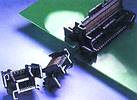Connector provides innovative Z-axis board-to-board solution
14 August 2002
Interconnection

Molex's SliderZ board-to-board connector helps minimise assembly, service, and retrofit costs. When servicing, upgrading and executing plug-in expansions on printed circuit boards, previous board-to-board solutions required the use of ribbon cable and several connectors linking the two boards together. The SliderZ connector, with its 1,27 mm pitch and 'slide' mating action, allows the user to mate or remove one PCB in the Z-axis while leaving the other PCB's undisturbed. Available in 10 through 60 select circuit sizes, this versatile connector can be used in a wide range of applications, including consumer electronics. The SliderZ connector is rated for up to 1000 mating cycles, for applications requiring frequent service.
The hermaphroditic design means the same connector is used in mating, which means only one part number needs to be ordered and inventoried. Guide rails and generous lead-ins help make installation and board-to-board mating easy.
Featuring glass-filled polyester housings, the connectors are UL 94 V-0 approved and have an operating temperature of -40 to 85°C. With current ratings of 1,5 A for the 10 circuit connectors and 1,25 A for the 20 through 60-circuit connectors, the SliderZ connector has a voltage rating of 30 V a.c. rms (42 V peak). Select gold plated contacts improve conductivity and reduce required insertion forces. Prominent finger pulls allow for ergonomic unmating and minimise stress to the board and connector.
For more information: Avnet Kopp, 011 809 6100.
Further reading:
Understanding and controlling impedance in high-speed interconnects
Spectrum Concepts
Interconnection
[Sponsored] As data rates move well into the hundreds of gigabits per second, success increasingly depends on an invisible but critical factor: impedance.
Read more...
Low profile spring-loaded connectors
Spectrum Concepts
Interconnection
Mill-Max has announced the introduction of low-profile, surface mount additions to its 2 mm pitch spring-loaded connector range.
Read more...
Prefitted junction box solutions
Interconnection
Prepopulated junction boxes in popular terminal configurations, such as single- and three-phase, enhance convenience for both electrical wholesalers and contractors.
Read more...
Bulgin unveils new range of sustainable connectors
Avnet Abacus
Interconnection
The Standard Vitalis Buccaneer range of waterproof connectors is a bio-based alternative to Bulgin’s flagship series, the Standard Buccaneer, offering the same technical performance with improved sustainability.
Read more...
Possible copper cable crisis looms as global demand soars
Interconnection
With the world requiring up to 3 billion metric tons of copper by 2050 to support green energy transitions and developing nations’ infrastructure, far exceeding the 23 million metric tons mined in 2024, pressure on supply chains is mounting.
Read more...
High-reliability spring-loaded interconnects
Spectrum Concepts
Interconnection
These springs from Mill-Max are drop-in replacements for the standard springs, requiring no changes to the form or fit of the existing spring-loaded pins.
Read more...
Anoison PCB mount connectors for high-performance applications
Conical Technologies
Interconnection
With its wide selection, Anoison provides PCB mount connectors that combine precision, durability, and cost-effectiveness across industries.
Read more...
Connectors for the Smart Factory
Spectrum Concepts
Interconnection
[Sponsored] Designing networks for the smart factory can seem daunting, but the solutions are already available with Samtec providing a comprehensive range of interconnect technologies tailored to the demands of the modern factory.
Read more...
Mouser shares expert design solutions for advanced robotics development
Interconnection
Mouser Electronics has announced a new interactive eBook, ‘The Electric Workforce’, in collaboration with electronics manufacturer and connectivity innovator, Molex.
Read more...
Explosive zone connectors
Interconnection
The connector series design by Glenair is optimised for fast and easy crimp-contact wire termination, with ample wiring space in the cable housing and accessory hardware.
Read more...


